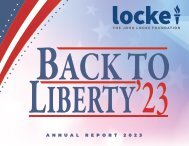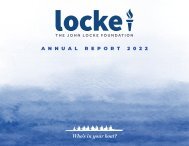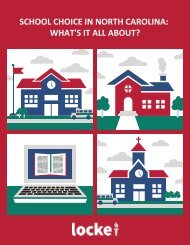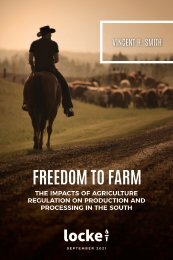Keeping the Peace Through Intensive Community Policing
As crime soars and the breakdown of public order takes its toll on our country, analysis from the John Locke Foundation signals it’s time to adopt a different approach to crime control, one that shifts the focus further upstream, looking at prevention models, rather than exclusively on punitive measures. In this July 2021 report, John Locke Foundation researcher and author Jon Guze explains that the current focus of catching, convicting, and punishing perpetrators after crimes have been committed has come with enormous economic and social costs. However, intensive community policing has proven successful at deterring crime and maintaining order, which leads to safer communities and fewer people living in poverty. Guze recommends a four-pronged plan to move forward with community policing: (1) hire more police officers (2) increase the pay for police officers (3) arm police officers with state-of-the-art training, direction, and support (4) deploy police officers as “peacekeepers” in communities that suffer most from crime and disorder.
As crime soars and the breakdown of public order takes its toll on our country, analysis from the John Locke Foundation signals it’s time to adopt a different approach to crime control, one that shifts the focus further upstream, looking at prevention models, rather than exclusively on punitive measures. In this July 2021 report, John Locke Foundation researcher and author Jon Guze explains that the current focus of catching, convicting, and punishing perpetrators after crimes have been committed has come with enormous economic and social costs.
However, intensive community policing has proven successful at deterring crime and maintaining order, which leads to safer communities and fewer people living in poverty. Guze recommends a four-pronged plan to move forward with community policing:
(1) hire more police officers
(2) increase the pay for police officers
(3) arm police officers with state-of-the-art training, direction, and support
(4) deploy police officers as “peacekeepers” in communities that suffer most from crime and disorder.
You also want an ePaper? Increase the reach of your titles
YUMPU automatically turns print PDFs into web optimized ePapers that Google loves.
72 KEEPING THE PEACE<br />
(September 2002): 1244–50, https://doi.org/10.1257/00028280260344777.<br />
39 Jonathan Klick and Alexander Tabarrok, “Using Terror Alert Levels to Estimate<br />
<strong>the</strong> Effect of Police on Crime,” The Journal of Law and Economics 48,<br />
no. 1 (April 1, 2005): 267–79, https://doi.org/10.1086/426877.<br />
40 Ibid.<br />
41 John M. MacDonald, Jonathan Klick, and Ben Grunwald, “The effect of private<br />
police on crime: evidence from a geographic regression discontinuity<br />
design,” Journal of <strong>the</strong> Royal Statistical Society: Series A (Statistics in Society)<br />
179, no. 3 (October 15, 2015): 831–46, https://doi.org/10.1111/rssa.12142.<br />
42 “Economic Perspectives on Incarceration and <strong>the</strong> Criminal Justice System,”<br />
Council of Economic Advisors Report, 40.<br />
43 Devi and Fryer, “<strong>Policing</strong> <strong>the</strong> Police,” 1.<br />
44 Aaron Chalfin, Benjamin Hansen, Emily K. Weisburst, and Morgan C. Williams,<br />
Jr., “When cities add cops, Black residents could have <strong>the</strong> most to<br />
gain — and <strong>the</strong> most to lose,” Niskanen Center, May 18, 2021, https://www.<br />
niskanencenter.org/when-cities-add-cops-black-residents-could-have-<strong>the</strong>most-to-gain-and-<strong>the</strong>-most-to-lose.<br />
The article summarizes <strong>the</strong>ir findings<br />
reported in Aaron Chalfin, Benjamin Hansen, Emily K. Weisburst, and<br />
Morgan C. Williams, Jr., “Police Force Size and Civilian Race,” NBER Working<br />
Paper No. 28202, (Cambridge, MA: National Bureau of Economic Research,<br />
December 14, 2020), https://doi.org/10.3386/w28202.<br />
45 Kelling and Wilson, “Broken Windows.”<br />
46 Regarding <strong>the</strong> proliferation of new crimes, see Jon Guze, “Overcriminalization,”<br />
Policy Position, John Locke Foundation, June 2, 2021, https://www.<br />
johnlocke.org/policy-position/overcriminalization; regarding <strong>the</strong> revival of<br />
civil asset forfeiture see Jon Guze, “Asset Forfeiture,” Policy Position, John<br />
Locke Foundation, January 2020, https://www.johnlocke.org/policy-position/asset-forfeiture;<br />
regarding <strong>the</strong> use of fines and fees as a source of<br />
revenue, see Jon Guze, “Lucky to Be Here” John Locke Foundation, March<br />
24, 2014, https://www.johnlocke.org/update/lucky-to-be-here/.<br />
47 Additional challenges include: reconciling <strong>the</strong> efficacy of swift and certain<br />
punishment with <strong>the</strong> requirements of due process; dealing effectively but<br />
humanely with those who suffer from untreated, or unsuccessfully treated,<br />
mental illness and addiction; minimizing <strong>the</strong> extent to which victimless<br />
crimes involving alcohol, drugs, prostitution, and gambling tend to corrupt<br />
<strong>the</strong> integrity of <strong>the</strong> officers involved and alienate <strong>the</strong>m from <strong>the</strong> community<br />
in which <strong>the</strong>y work; and responding appropriately to <strong>the</strong> fact that racial<br />
disparities are likely to persist, and may even worsen, as crime rates go<br />
down.<br />
48 Mark A.R. Kleiman, “When Brute Force Fails: Strategic Thinking for Crime











